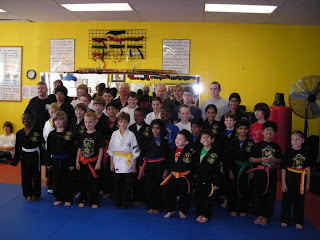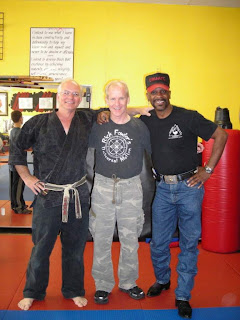Years ago I was teaching a private lesson to an adult black belt. In the middle of doing a section of Form Four she comes over to me, grabs my sleeve, and asks me what the patch was on it. I was joking that she was ADD because she did that and a few other quirky things during her lessons. You may have experienced that as well, which is why I thought you might want to read this, sent by Tim Walker of Branford, FL.
Are You an ADHD Adult?
It’s Not Just a Kids Disorder
By Edward C. Geehr, MD
Sunday, April 29, 2007
Got the lunches made. Oops, forgot to let the dog out. Need to pick up the dry cleaning. Michael’s hair is a mess. Do I have to take the car in today? I’ll need to reschedule my manicure. Anyone seen my keys? Is the carpool here already? If this scatter of thoughts seems familiar, you may be one of the estimated six to 15 million adults with ADHD…Your inattention and restlessness may not only be the quirks of your personality. You may have ADHD (attention-deficit / hyperactivity disorder), a behavioral disorder that most of us associate with unruly children. But, in fact, about 65% of children with ADHD carry the disorder into adulthood, making it an adult problem as well.Although ADHD adults may develop better coping skills than they had as children, they still struggle to get through the day. Not only does ADHD interfere with organizing and completing daily tasks, but adults with the disorder are also prone to depression, anxiety, forgetfulness, and even an increased risk of divorce and car accidents. Even simple duties may demand great concentration and effort. In part, that’s because ADHD adults are easily distracted by sound, sight, or even touch. Whatever the stimulus, ADHD adults may be knocked off-course by even minor distractions.
The three core symptoms of ADHD are inattention, hyperactivity and impulsive behavior. The symptoms of inattention include losing track of thoughts or focus in the middle of tasks; missing details or making careless mistakes; inability to complete work assignments; forgetfulness; and difficulty following instructions.The symptoms of hyperactivity in adults are similar to those in children but more subtle: constantly shifting in a chair, tapping your feet or a pencil, playing or tugging at hair or clothing. Even those aware of their repetitive motions may be unable to stop.Impulsive behavior can be even more annoying in adults than in kids – and potentially dangerous. ADHD adults tend to bug the rest of us: We wish they would “grow up.” They tend to interrupt constantly or blurt out inappropriate comments. They can’t stand waiting in lines and may try to cut in front or find a “friend” near the head of the line. They also have trouble anticipating the consequences of their actions. Although this lack of foresight in children can be disruptive, in adults it can threaten families, jobs and even safety. A young ADHD adult paired with a car can be a dangerous combination.
In the workplace, ADHD can erode performance. Some people with ADHD change jobs often or have trouble holding a job. The way they handle tasks shifts from one to the next: One assignment is done well, but the next is late, poorly done or incomplete. The ADHD adult feels like he breezes through some tasks but he can’t get any traction on or stay interested in others. Co-workers are puzzled by this variability, often attributing it to personal problems or even substance abuse.Unfortunately, scientists don’t yet know the cause of ADHD and laboratory tests can’t confirm a diagnosis. They do know, however, that the disorder runs in families. If you have a parent with the disorder, you have more than a 50% chance of having it as well. If you have a child with ADHD, you have a 25% chance of already having the disorder yourself. Unlike childhood ADHD, which affects three times as many boys as girls, adult ADHD is more democratic, evenly distributing itself between genders.Doctors diagnose ADHD based on family, developmental and childhood history, current signs and symptoms. Still, ruling out potentially serious and/or treatable neurological disorders that can mimic ADHD symptoms, such as Tourette’s Syndrome, temporal lobe seizures, early stage brain tumor, elevated blood lead levels, hypo- or hyperthyroidism, and hearing or vision impairment, is important.Most workups for detecting ADHD include a physical exam. Some doctors will also request an EEG (electroencephalogram, which records the electrical activity of the brain), CT (computed tomography, or x-ray procedure, that records cross-sectional pictures of parts of the body, in this case the brain) or MRI (magnetic resonance imaging, a diagnostic technique that produces cross-sectional images of any body part, in this instance the brain) to rule out other conditions.
ADHD has no cure. Fortunately, several drug treatments – primarily stimulants – are effective for both children and adults. Approximately two-thirds of ADHD adults taking stimulants experience significant improvements. And the drugs take effect fast, a remarkable finding. Few medications have such a profound and immediate effect. Unfortunately, most stimulants wear off quickly each day, returning adults to their usual difficulty of completing tasks and staying focused. Many ADHD adults turn to coffee. In fact, some can’t do without it; caffeine’s stimulating effect helps them focus and stay on task. In fact, some get so much relief from coffee that they become caffeine abusers, drinking excessive amounts of coffee each day.Stimulant medications, also called psychostimulants, include Ritalin® and Ritalin LA®, Methylin®, Metadate®, Concerta®, and Adderall® and Adderall XR®. Several of these brands offer long-acting formulations to reduce the need for frequent dosing. Only Adderall XR® is indicated for the treatment of ADHD in children, adolescents and adults.Non-stimulant medications are also available, including Wellbutrin® and Straterra®. Available since 2003, Straterra® is the first non-stimulant medication approved to control ADHD symptoms in children, adolescents and adults. Wellbutrin® is sometimes used “off-label” for treatment of combined conditions such as ADHD and depression. Off-label means that doctors prescribe the drug for disorders not officially approved by the Federal Drug Administration (FDA).Adults can also complement any drug therapy by using a few coping strategies. These include taking medications as directed (don’t double up if you miss a dose); making lists of tasks and keeping them nearby; taking a deep breath or excusing yourself from situations when you feel tempted to act out or interrupt; recognizing and minimizing stimuli that distract you (sounds, sights and physical sensations); and engaging in activities that you find calming or comforting such as gardening, walking or cooking.
Here are some questions to consider if you think you may have ADHD:
Does your mind wander while you are working on a task?
Are you easily distracted?
Do you tend to start a project and have difficulty completing it?
Does your attention stray in the middle of a conversation?
Are you forgetful about appointments and regular events?
Do you have difficulty relaxing?
Are you impatient when you need to wait?
Do you fidget and shift constantly in your seat?
Do you commonly lose track of keys, purses and other items?
Do you interrupt others before they finish speaking?
Is it difficult for you to manage or resolve conflicts?
If these issues sound familiar, you may want to consult a healthcare professional.
Resources:National Resource Center on ADHD Children and Adults with Attention-Deficit / Hyperactivity Disorder (
www.help4adhd.org)Attention Deficit Information Network, Inc. (
www.addinfonetwork.com)
 Saturday started at 9am, with the rest of the attendees checking in and renewing old acquaintances as well as meeting some new friends. The morning topics covered basics and forms but were related to the Laws of Learning and Levels of Learning, information that instructors should know. Lunch was arranged for us in the next room and was excellent.
Saturday started at 9am, with the rest of the attendees checking in and renewing old acquaintances as well as meeting some new friends. The morning topics covered basics and forms but were related to the Laws of Learning and Levels of Learning, information that instructors should know. Lunch was arranged for us in the next room and was excellent.















